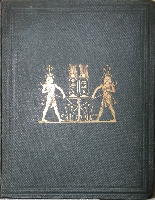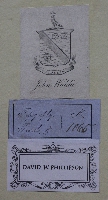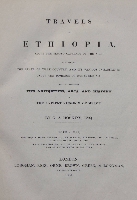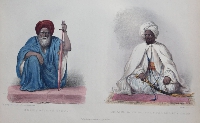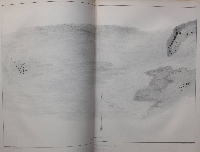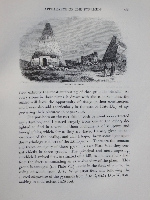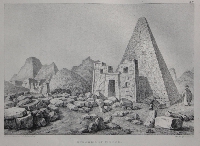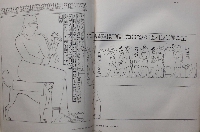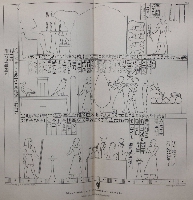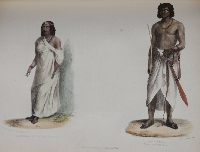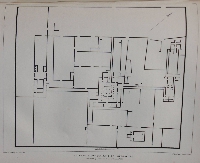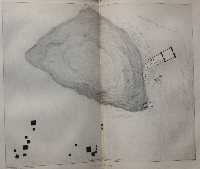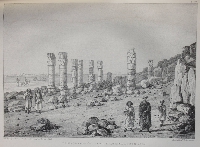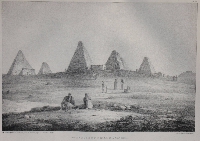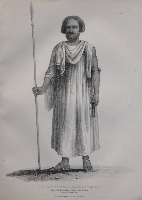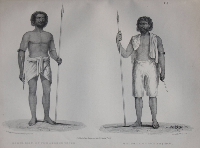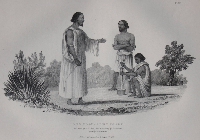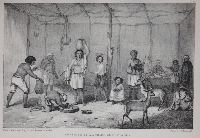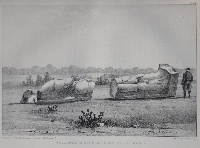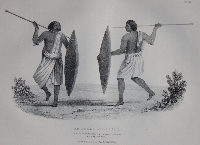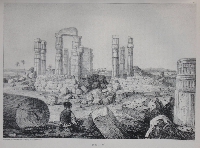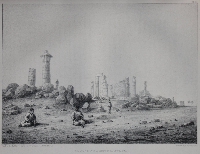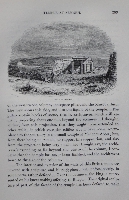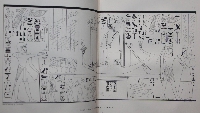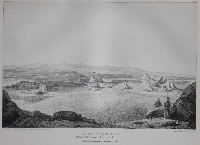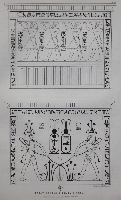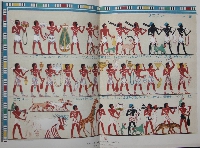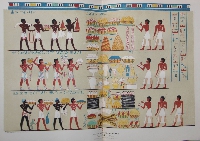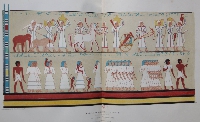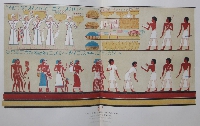Travels in Ethiopia, above the second cataract of the Nile: exhibiting the state of that country, and its various inhabitants, under the dominion of Mohammed Ali and illustrating the antiquities, arts, and history of the ancient kingdom of Meroe.
Year: 1835
Edition: First edition
Publisher: London: Longman, Rees, Orme, Brown, Green & Longman
Category: Egypt
Publisher's cloth, 4to, pp. xix, 1, folding map, 367, 1.
A large folding map plus 53 ƒƒ of plates, of which two finely coloured by hand, four chromolithographed and one ƒ printed on both sides, resulting in a total of 54 lithographs. There are six double page plates and 35 woodcuts in the text. The two leaves coloured by hand have two plates each. Some of the b/w lithographs have two plates as well.
The chromolithographs present are the earliest in an English printed book (¹). Largely uncut, and untrimmed; various pages unopened, original publisher's blind-stamped cloth gilt, light wear to extremities and the rear board beginning to split at the head of the spine, but joints strong.
On the front pastedown there is the armorial bookplate of John Waldie of Hendersyde Park (3) with his hand-numbered shelfmark label and another bookplate of David. W. Phillipson.
The plates are remarkably free from foxing, but the folding map, which shows the course of the Nile in this part of Africa, is quite foxed.
Plates lithographed by John Arrowsmith, Robert Jacob Hamerton, W.L. Walton, Joseph Bonomi, and William P. Sherlock; after G.A. Hoskins and L. Bandoni. Plates printed by Charles Joseph Hullmandel. An attractive copy of an important source on Egyptology, Sudan (Nubia), Ethiopia and Meroe.
With a map, and ninety illustrations of the temples, pyramids, etc. of Meroe, Gibel el Birkel, Solib, etc., from drawings finished on the spot, by the author, and an artist (Bandoni) whom he employed.
Edgar Allan Poe; Critical Notices, from Southern Literary Messenger, August 1835, p. 714:
“Mr. Hoskins' Travels in Ethiopia above the Second Cataract of the Nile, are very highly spoken of. The work is a large quarto; and the expense of getting it up has been so great, as to leave its author no chance of remuneration. It contains ninety illustrations, by a Neapolitan artist of great eminence. The risk attending the publication of so valuable a book, will operate to deter any American bookseller from attempting it.”
(Actually it was Hullmandel who was left no chance of remuneration as Mr. Hoskins, after 125 copies of the chromolithographs had been printed, was not satisfied with the colour of the skull caps of the Nubians depicted on the first one, where there should be blue skull caps instead of black ones, and Hullmandel had to change two stones (²) .)
The retail price of this book at the time was set at £3 13s 6d, which was an excessive price for a book in those days, and thus obtainable only for the wealthy.
The British archaeologist George Alexander Hoskins (1802 - 1863), visited Egypt and the Sudan for the first time in 1833. For a while he worked together with Robert Hay. He toured the northern region together with the artist Luchese Bandoni whom he employed, making archaeological drawings and notes throughout his tour resulting in this book.
Afterwards two more books were published: "Visit to the Great Oasis of the Libyan Desert" in 1837 and "A Winter in Upper and Lower Egypt" in 1863.
After his encounter with the Arab tribes of northern Sudan, he had this to say, sharing the view of other European travellers, that an Arab accepts whatever comes across his way with unquestioned resignation (p. 60):
Endowed with an imperturbable stock of apathy more comfortable perhaps, although not so intellectual as European philosophy, they submit to a distressing accident, which would throw one of our countrymen almost into fever, without allowing their equanimity to be in the least disturbed. ‘Mactub min Allah’, it is written, 'it is the will of God,’ they explain with placid resignation, and instead of brooding over their misfortune, become immediately reconciled to it, and with amazing facility banish it from their thoughts.
In this book Mr. Hoskins writes on the commerce of Meroe (p. 344):
In a country where the arts are now totally unknown, and which is become little better than a desert, it is not surprising to find commerce reduced to the mere exchange of the most absolute necessaries of life, and a few trifling superfluities. Small caravans occasionally go from Shendy to Abyssinia. Sometimes the rulers of the latter country do not permit them to enter their dominions, and civil wars not unfrequently put an entire stop to the trade ; but when, as is generally the case, the merchants succeed in procuring an entrance, they inform me that the profits on their Cairo goods are enormous. They receive in exchange a little ivory ; gold, the value of which is several dollars per ounce lower there than in Egypt ; a very fine species of cotton scarf, much esteemed and worn by the Abyssinian women in the Turkish harems, and the Abyssinian coffee; which, although not equal to the Mocha, is almost the only kind drunk in Nubia : but their chief return is in slaves. The wars which generally distract that unfortunate country furnish to each state abundance of these victims, which, like cattle, are exchanged with the merchant for the luxuries of Egypt ; few are the Turks who have not Abyssinian girls in their harems, and I have seen numerous eunuchs brought from that country. It is horrid to think that beings called Christians should be guilty of such enormities ; but there is no doubt of the fact. The slaves, whether girls or boys, by compulsion or inclination, invariably become Mahometans.
This scarce book is of primary importance as a source of knowledge for Egypt, Nubia and Meroe. After the discovery by Frédéric Cailliaud, this is the first book in English to describe Meroe. The plates depict landscapes, people, plants, ruins, etc. There are plans of the sites visited and much of it has disappeared. Moreover it is an important book in the history of English bookprinting as it contains four magnificent colour litho’s, being the first chromolithographs ever printed in the United Kingdom (¹).
There is some controversy about the accuracy of some of the plates of Meroe, as compared to those done by Cailliaud (for more details click here).
(¹) Bamber Gascoigne: "Milestones in colour printing 1457-1859", Cambridge University Press, 1997.
While researching the story behind these first chromolithographs printed in the UK, Mr. Gascoigne found out that there were 525 copies printed of this book and that the number of colours used in part of the process was eight (²) instead of the expected four.
(²) Footnote by Mr. Hoskins: "I regret that in some few of the impressions the caps were printed black."
Mr. Gascoigne: "He would be distressed to know that these 'few impressions' are probably the majority of those surviving a century and a half later."
Till the end of the 20th century it was considered a fact that the first chromolithographs printed in Great Britain were those done by Owen Jones in 1836 for his work "Plans, Elevations, Sections, and Details of the Alhambra", hence outdating the patent of Godefroy Engelmann which was registered in France in 1837, but after the chromolithographs done by Barth in Germany, towards the end of the second decade of the 19th century.
In "Milestones in colour printing" Mr. Gascoigne describes how he came across a 1920's bookseller's catalogue in which a copy of this book was listed, which the cataloguer described as illustrated with chromolithographs.
Mr. Gascoigne: "Booksellers frequently get their prints wrong, so I awaited its arrival in the British Library without too much expectation. But Maggs was right, they were indeed chromolithographs..."
According to Mr. Gascoigne there were four colours used for the first series of the chromolithographs depicting the skullcaps in black. These chromolithographs were finished by hand colouring, while Hullmandel, due to the experience he gained with the first series of 125 copies, used eight colours for the remainder with the blue skullcaps, which plates are far superior to those finished by hand colouring (according to Mr. Gascoigne).
In our copy the Nubians are depicted with blue skull caps (pict. #32, top row at the right side) and there are some more colour changes in these chromolithographs, like for instance clearly visible in the bottom row of part 2 of the Grand Procession. By clicking the link here below, you can see a picture of Nubians with black skull caps from the copy in the New York Public Library.
(3) John Waldie (1781-1862) was the administrator of Hendersyde Park at Kelso, Roxburghshire, Scotland. While a student at the University of Edinburgh, he began to keep daily journals recording his extensive travels and his observations of theaters, museums, and concert halls. An accomplished tenor, Waldie performed at private entertainments with Angelica Catalani, Michael Kelly, and John Braham; met with the composer Gioachino Rossini; and socialized with such well-known actors as John Philip Kemble and Sarah Siddons. Waldie also served on the committee of the Theatre Royal, Newcastle, as one of its proprietors. He was the brother of Jane (Waldie) Watts (1793-1826) and Charlotte (Waldie) Eaton (1788-1859), whose diaries are cataloged as Osborn d182, Osborn d186, and Osborn d187 (source: Social Networks and Archival Context).
A mesmerizing book, only seldom found in its original publisher's binding.
Blackmer 832, Gay 2574, Hess & Coger 1376, Prince Ibrahim-Hilmy I, p. 310.
Link: https://digitalcollections.nypl.org/items/510d47e1-db70-a3d9...
Click on a picture to enlarge.

